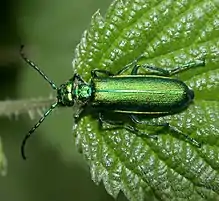مگس اسپانیایی
مگس اسپانیایی (نام علمی: Lytta vesicatoria) یک سوسک زمردیرنگ از تیرهٔ سوسک تاول (Meloidae) است. این حشره منبع ترپنوئید کانتاریدین است، یک عامل مخرب سمی که در قدیم بهعنوان داروی مقوی باء کاربرد داشتهاست.
| مگس اسپانیایی | |
|---|---|
 | |
| آرایهشناسی | |
| فرمانرو: | جانوران |
| شاخه: | بندپایان |
| رده: | حشره |
| راسته: | قاببالان |
| تیره: | سوسک تاول |
| زیرخانواده: | Meloinae |
| تبار: | Lyttini |
| سرده: | Lytta |
| گونه: | L. vesicatoria |
| نام علمی | |
| Lytta vesicatoria (کارل لینه, 1758) | |
L. vesicatoria گاهی اوقات Cantharis vesicatoria نیز نامیده میشود.[1] گرچه جنس Cantharis در یک خانواده غیر مرتبط، Cantheridae، است.[2]
شرح و ریشهشناسی

مگس اسپانیایی یک حشره سبز-طلایی رنگینتاب، فلزمانند با بدن نرم و باریک است. این حشره حدود ۵ میلیمتر (۰٫۲۰ اینچ) عرض ۲۰ میلیمتر (۰٫۷۹ اینچ) طول دارد.[3][4][5][6]
نام علمی این حشره از واژهٔ یونانی (λύττα (lytta به معنی تهاجم جنگی، جنون تهاجمی، مایندادس یا هاری[7][8] و واژهٔ لاتین vesica به معنی تاول گرفته شدهاست.[9]
محدوده و زیستگاه
مگس اسپانیایی عمدتاً گونهٔ جنوب اروپا است[10][11] اگرچه گسترهٔ زیستگاههای آن بهطور کامل به صورت «در سراسر جنوب اروپا و از شرق به آسیای مرکزی و سیبری» توصیف شدهاست،[3] متناوباً در سراسر اروپا و بخشهایی از شمال و جنوب آسیا (به استثنای چین).[12]
این حشرات در بزرگسالی در درجه اول روی برگ زبان گنجشک، یاس خوشهای، پیچ امینالدوله و درخت بید سفید تغذیه میکنند در حالی که گاهی اوقات روی برگهای آلو، رز و نارون نیز دیده میشوند.[3][13]
کاربرد در آشپزی
در مراکش و دیگر نقاط شمال آفریقا، مخلوط ادویهای که به نام رأس الحانوت شناخته میشود، گاهی شامل ترکیبات جزئی از «سوسکهای فلزی سبز» میشود که اشاره به کانتریدس (پودر کانتاریدین) گرفتهشده از این نوع سوسک دارد، گرچه فروش این ادویه در بازار ادویه مراکش در دهه ۱۹۹۰ ممنوع شد.[14] Dawamesk، نوعی پرورده در شمال آفریقا و حاوی حشیش، خمیر بادام، پسته، شکر، پرتقال یا پوست تمبر هندی، میخک و دیگر ادویهجات مختلف، گاهی اوقات شامل کانتاریدس نیز میشود.[15]
کاربردهای دیگر
در چین باستان، این سوسکها با مدفوع انسان، آرسنیک و اقونیطون برای ساخت اولین بمب ثبتشده در جهان مخلوط میشدند.[16]
منابع
- Anon. (2012) [2009]. "Cantharide". Farlex Partner Medical Dictionary. Huntingdon Valley, PA, USA: Farlex. Retrieved 14 December 2015.
- Selander, Richardg B. (1991). "On the Nomenclature and Classification of Meloidae (Coleoptera)". Insecta Mundi. 5 (2): 65–94.
- Schlager, Neil, ed. (2004). "Coleoptera (beetles and weevils)". Grzimek's Animal Life Encyclopedia. vol. 3, Insects (2nd ed.). Farmington Hills, MI, USA: Thomson-Gale/American Zoo and Aquarium Association. p. 331. ISBN 978-0-7876-5779-6. Retrieved 20 December 2015.
- Aggrawal, Anil, ed. (2007). "VII. Spanish Fly (Cantharides)". APC Textbook of Forensic Medicine and Toxicology. New Delhi, India: Avichal. p. 652f. ISBN 978-8177394191. Retrieved 14 December 2015.
- Blood, Douglas Charles, ed. (2007). "Cantharides". Saunders Comprehensive Veterinary Dictionary (3rd ed.). Philadelphia, PA, USA: Elsevier. ISBN 978-0-7020-2788-8. Retrieved 14 December 2015.
- Jonas, Wayne B., ed. (2005). "Cantharides". Mosby's Dictionary of Complementary and Alternative Medicine (3rd ed.). Philadelphia, PA, USA: Elsevier Saunders. ISBN 978-0-323-02516-4. Retrieved 14 December 2015.
- Liddell, Henry George; Scott, Robert (1940). "λύττα, λυττάω, λυττητικός, etc. , v. λυσς-". Liddell & Scott. Archived from the original on 18 February 2019. Retrieved 14 February 2017.
- Liddell, Henry George; Scott, Robert (1940). "λύσσα". Liddell & Scott. Archived from the original on 18 February 2019. Retrieved 14 February 2017.
- "vesico-, vesic-". English-Word Information. Retrieved 14 February 2017.
- Cutler, H.G. (1992). "An Historical Perspective of Ancient Poisons". In Nigg, H.G. Phytochemical Resources for Medicine and Agriculture. p. 3. doi:10.1007/978-1-4899-2584-8_1. ISBN 978-1-4899-2586-2.
- The Eds. of Encyclopædia Britannica (2015). "Blister beetle, insect". Encyclopædia Britannica (online). Chicago, IL, USA: Encyclopædia Britannica. Retrieved 14 December 2015.
- Guala, Gerald, ed. (2015). "Geographic Information: Geographic Division". ITIS Report: Lytta vesicatoria (Linnaeus, 1758), Taxonomic Serial No. : 114404. Reston, VA, USA: U.S. Geological Survey, Integrated Taxonomic Information System (ITIS). Retrieved 20 December 2015.
- Neligan, J.M. & R. Macnamara (1867). Medicines, their uses and mode of administration; including a complete conspectus of the three British Pharmacopoeias, an account of all the new remedies, and an Appendix of Formulae. Fanin & Company. p. 297.
- Davidson, Alan (1999). Jaine, Tom, ed. The Oxford Companion to Food. Vannithone, Soun (illustrator). Oxford, ENG: Oxford University Press. p. 671f. ISBN 978-0-19-211579-9. Retrieved 13 December 2015.
- Green, Jonathon (12 October 2002). "Spoonfuls of paradise". The Guardian. Retrieved 14 February 2017.
- Theroux, Paul (1989). Riding the Iron Rooster. Ivy Books. p. 54. ISBN 978-0-8041-0454-8.